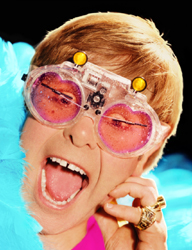Can You Innovate Without Craziness?
 Bizarre and weird behavior isn’t the source of innovation. Innovation is satisfying customers’ unmet desires. Unless your customers’ want to watch you act crazy then bizarre behavior is not innovative.
Bizarre and weird behavior isn’t the source of innovation. Innovation is satisfying customers’ unmet desires. Unless your customers’ want to watch you act crazy then bizarre behavior is not innovative.
All you need to satisfy customers’ unmet desires is to understand your customers and have a system for creating products and services that do more of what customers want. That sounds remarkably sane.
So why all the hype about acting like a lunatic to be innovative?
Innovation by definition is change. Crazies love change, any change, the wilder the better. Sensible people naturally avoid most change because it also produces risk. But sane logical people change all the time. What they want to avoid is risky change that doesn’t provide value. Give a sane well adjusted person a low-risk high value improvement and they will gladly accept that change.
How does an intelligent sensible person innovate? They use the Predictive Innovation Method.
First the Predictive Innovation Method accurately describes what customers want as objective outcomes you can easily communicate and measure.Then it uses a straightforward process to reveal the 105 different types of innovation for each outcome. This tells you what will satisfy customers and how to do it. And because you already know there are 105 specific types divided into 15 categories you can clearly tell when you have all the answers you need. Plus, since you can see all the answers the risk practically is eliminated. Simply choose the option that best satisfies customers and produces the most reward with the least risk. And when you are ready for the next innovation you already have all the choices waiting.
The Predictive Innovation Method allows you to deliver the Right Product in the Right Way at the Right Time.
Lets look at an example to see how the Predictive Innovation Method works.
When customers buy a product or service they are trying to accomplish some goal. They usually aren’t interested in the product but rather what it does for them. In other words, ??people don’t buy drills, they buy holes.??
Each goal is made up of a set of criteria called outcomes. To accomplish the overall goal each of the outcomes must be fulfilled. Outcomes vary between goals but each goal always has the same outcomes. The outcomes never change. The requirements for drilling a hole have always been the same and will always be the same. Cooking has a set of outcomes, drilling has a set of outcomes, and shoes perform tasks that have a set of outcomes.
Here are the outcomes for shoes.
- stays on
- provides comfort
- grips surface
- prevents injury
- looks attractive
Shoes have improved a lot over time. There have been many improvements to each of the outcomes. There are laces, elastic, buckles, and zippers to achieve the outcome of ??stays on.?? As much as each outcome has been improved the ultimate shoe has never been achieved and will likely never be achieved.
The ultimate shoe:
- stays on every time you want and only when you want.
- is comfortable in every way and at all times and places on anyone
- grips the surface when and in the way you need
- prevents all types of injury under all conditions and uses
- are attractive anywhere, anytime, with all your clothes
and it does all this for the price the customer wants with no hassle.
The ultimate shoe is the end goal, the direction all innovations head. The path between here and there contains all the possible innovations for shoes. The 105 types of innovation show you each step along the way and that is how Predictive Innovation works.





 Predictive Innovation Training
Predictive Innovation Training Predictive Innovation: Core Skills Book
Predictive Innovation: Core Skills Book RoundSquareTriangle.com
RoundSquareTriangle.com